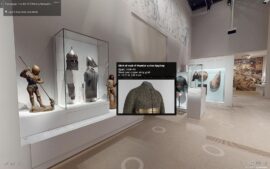Virtual Reality (VR) has become a game-changer in education, offering immersive experiences that enhance learning in diverse ways. This article explores ten innovative ways to implement VR in education, providing insights into the approach, goals, costs, and key performance indicators (KPIs). Each case study showcases successful applications of VR, highlighting its potential to revolutionize the educational landscape.
1. Virtual Field Trips
Approach:
Utilize VR to transport students to locations they might not otherwise have access to, enhancing their understanding of various subjects.
Goals:
- Provide an immersive learning experience.
- Foster a deeper understanding of geography, history, and culture.
Costs:
Moderate to high, depending on the level of detail and interactivity.
KPIs:
- Student engagement levels.
- Knowledge retention through post-trip assessments.
Case Study:
Google Expeditions has successfully implemented virtual field trips, allowing students to explore the Great Barrier Reef or the Pyramids of Giza without leaving the classroom.
2. Virtual Laboratories
Approach:
Simulate complex experiments and procedures in a virtual lab environment.
Goals:
- Provide a risk-free space for hands-on learning.
- Overcome resource constraints in physical labs.
Costs:
Moderate, with potential savings in terms of equipment and maintenance.
KPIs:
- Improvement in practical knowledge.
- Student performance in simulated experiments.
Case Study:
Labster offers a wide range of virtual labs in biology, chemistry, and physics, enabling students to conduct experiments in a virtual setting.
3. Historical Time Travel
Approach:
Immerse students in historical events using VR to bring history to life.
Goals:
- Enhance historical understanding.
- Foster empathy and connection to historical events.
Costs:
Moderate, with potential for collaboration with historical institutions.
KPIs:
- Improved historical knowledge.
- Student engagement with historical content.
Case Study:
The Anne Frank House VR experience allows students to virtually explore the hiding place of Anne Frank during World War II.
4. Language Immersion
Approach:
Create VR environments where students can immerse themselves in foreign language contexts.
Goals:
- Improve language comprehension.
- Enhance cultural understanding.
Costs:
Moderate, with potential for collaboration with language learning platforms.
KPIs:
- Language proficiency improvement.
- Cultural sensitivity development.
Case Study:
Immersive VR platforms like MondlyVR provide language learners with realistic conversational scenarios.
5. Architectural Visualization
Approach:
Enable students to design and explore 3D architectural models in virtual environments.
Goals:
- Enhance spatial awareness and design skills.
- Facilitate collaborative projects.
Costs:
Moderate to high, depending on the complexity of the models.
KPIs:
- Quality of design projects.
- Collaborative problem-solving skills.
Case Study:
The IrisVR platform allows students and professionals to visualize architectural designs in VR, facilitating better understanding and collaboration.
6. Virtual Study Groups
Approach:
Create virtual spaces for collaborative studying and discussion.
Goals:
- Facilitate remote learning.
- Encourage peer-to-peer interaction.
Costs:
Low to moderate, depending on the platform used.
KPIs:
- Participation levels.
- Improvement in collaborative learning outcomes.
Case Study:
EngageVR provides a virtual space for students to study together, fostering a sense of community in online learning environments.
7. Career Simulations
Approach:
Offer VR simulations of real-world workplaces to prepare students for their future careers.
Goals:
- Improve career readiness.
- Provide a practical understanding of job roles.
Costs:
Moderate, with potential industry collaboration.
KPIs:
- Successful transitions to the workforce.
- Student feedback on career preparedness.
Case Study:
VirtualSpeech offers VR simulations for job interviews, public speaking, and workplace scenarios, aiding in career preparation.
8. Medical Training Simulations
Approach:
Develop VR simulations for medical students to practice surgeries and procedures.
Goals:
- Enhance practical medical skills.
- Provide a risk-free learning environment.
Costs:
Moderate to high, considering the complexity of medical simulations.
KPIs:
- Improvement in surgical proficiency.
- Reduction in medical errors.
Case Study:
Touch Surgery provides a VR platform for medical professionals and students to practice surgeries in a realistic virtual environment.
9. Physics Simulations
Approach:
Create VR simulations to help students visualize and understand complex physics concepts.
Goals:
- Improve understanding of abstract principles.
- Increase interest in STEM subjects.
Costs:
Moderate, with potential for collaboration with educational content providers.
KPIs:
- Improvement in physics comprehension.
- Student engagement in STEM courses.
Case Study:
The PhET Interactive Simulations project incorporates VR elements to make physics simulations more interactive and engaging for students.
10. Mindfulness and Stress Reduction
Approach:
Implement VR experiences designed to reduce stress and promote mindfulness.
Goals:
- Enhance well-being and mental health.
- Provide tools for stress management.
Costs:
Low to moderate, depending on the complexity of mindfulness programs.
KPIs:
- Reduction in stress levels.
- Improved mental health indicators.
Case Study:
VR platforms like Oculus offer guided meditation and relaxation experiences designed to alleviate stress and promote mental well-being.
Virtual Reality is revolutionizing education by providing immersive and interactive experiences that cater to various learning needs. From virtual field trips to medical training simulations, the implementation of VR in education opens new possibilities for engaging, effective, and personalized learning experiences. As technology continues to advance, the educational landscape is sure to benefit from the transformative power of Virtual Reality.



